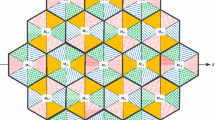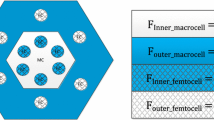Abstract
The next generation heterogeneous networks are expected to offer higher data-rate and better QoS to the customers by leveraging smaller cells like femtocells and making use of orthogonal frequency division multiple access. However, uncoordinated dense deployment of femtocells in macrocell network pose unique challenges involving cross-tier interference and resource management which results in significant degradation of the system performance. As part of addressing these challenges for the successful integration of both technologies, this paper proposes the deployment of a self-organizing femtocell network that employs an opportunistic smart frequency reuse technique –cross polarized complementary frequency allocation (CPCFA). It exploits the frequency and polarization diversity to mitigate interference in two-tier femto-macro networks. In this work, a strategy combining the adoption of reverse frequency allocation and orthogonal polarized transmission is analyzed as a potential solution for maximizing spectral efficiency and minimizing interference in the existing heterogeneous networks. Focus of the current work is on downlink transmission where the traffic is high and the deployment of femtocell is more beneficial. The results of analytic and simulation studies prove that CPCFA increases the scope for an easily implementable, remarkable opportunity in the context of two-tier femto-macro network that can substantially increase the system capacity as well as cell coverage without additional network complexities.










Similar content being viewed by others
References
Realwireless report for Ofcom, “4G capacity gains, final report,” 2011.
GPP TR 32.816, Telecommunication management; study on management of Evolved Universal Terrestrial Radio Access Network (E-UTRAN) and Evolved Packet Core (EPC) (Release 8) v1.3.1, 2007.
Yavuz, M., Meshkati, F., Nanda, S., Pokhariyal, A., Johnson, N., Roghothaman, B., & Richardson, A. (2009). Interference management and performance analysis of umts/hspa + femtocells. IEEE Communications Magazine, 47(9), 102–109.
Young, J. S., Hae, G. H., & Kwang, K. S. (2009). “A self organised femtocell for IEEE 802.16e system.” In Proceedings of IEEE Global Telecommunications Conference, pp. 1–5, December 2009.
Berg, J. L. V. D., Litjens, R., Eisenbltter, A., Amirijoo, M., Linnell, O., Blondia, C., et al. (2008). Self-organisation in future mobile communication networks. ICT - Mob Summit, Sweden, 2, 915–920.
Zetterberg, K., Scully, N., Turk, J., Jorguseski, L., & Pais, A. (2010). “Controllability for self-optimisation of home enodebs,” COST 2100, Joint Workshop COST 2100 SWG 3.1 and FP7-ICT-SOCRATES, Greece, February 2010.
I. Balan, “Self-optimisation in 3gpp lte networks,” Dec., 2009.
Aldaya, I., Campuzano, G., Gosset, C., Giacoumidis, E., Doran, N. J., Mikroulis, S., & Castanon, G. (2013). “Novel cost-effective PON-to-mm-wave RoF photonic bridge for multigigabit access networks.” In Proceedings of International Conference on Transparent Optical Networks (ICTON), pp.1–4, June 2013.
Lopez-Perez, D., Roche, G., Valcarce, A., Juttner, A., & Zhang, J. (2008). “Interference avoidance and dynamic frequency planning for WiMAX femtocells networks.” In Proceedings. of IEEE international conference on communication systems.
Saatsakis, A., Demestichas, P., Merat, V., Page, C. L., Loewel, T., & Nolte, K. (2009). “Femtocell and flexible base station cognitive management.” In Proceedings of IEEE international symposium on personal, indoor and mobile radio communications, pp. 1–5, September 2009.
Lopez-Perez, D., Ladanyi, A., Juttner, A., & Jie, Z. (2009). “OFDMA femtocells: A self-organizing approach for frequency assignment.” In Proceedings of IEEE international symposium on personal, indoor and mobile radio communications, pp. 2202–2207, September 2009.
Saquib, N., Hossain, E., & Kim, D. I. (2013). Fractional frequency reuse for interference management in LTE-advanced hetnets. IEEE Wireless Communications, 20(2), 113–122.
Jacob, P., James A., & Madhukumar, A. S. (2012). “Downlink capacity improvement and interference reduction through reverse frequency allocation.” In Proceedings of IEEE international conference on communication systems, pp. 329–333, November 2012.
Jacob, P., Madhukumar, A. S., & James, A. (2014). Interference mitigation through reverse frequency allocation in multi-tier cellular network-a downlink perspective. Wireless Networks-Springer Journal,. doi:10.1007/s11276-014-0868-x.
Jacob, P., Madhukumar, A. S., & Alphones, A. (2013). Interference mitigation through cross polarized transmission in femto-macro network. IEEE Communication Letters, 17(10), 1940–1943.
Jacob, P., Madhukumar, A. S., & Alphones, A. (2014). Orthogonal circular polarized transmission for interference control in femto-macro networks. Computer Communications- Special Issue on Networking and Communications for Smart Cities,. doi:10.1016/j.comcom.2014.09.004dlx.
Oestges, C., Erceg, V., & Paulraj, A. (2004) “Propagation modeling of multi-polarized mimo fixed wireless channels”, In IEEE transactions on vehicular technology, 53(3).
Yildirim, F., Sadri, A. S., & Liu, H. (2008). Polarization effects for indoor wireless communications at 60 GHz. IEEE Communication Letters, 12(9), 660–662.
Rappaport, T. S., & Hawbaker, D. A. (1992). Wide-band microwave propagation parameters using circular and linear polarized antennas for indoor wireless channels. IEEE Transactions on Communications, 40, 240–245.
Sato, K., Manabe, T., Ihara, T., Saito, H., Ito, S., Tanaka, T., et al. (1997). Measurements of reflection and transmission characteristics of interior structures of office building in the 60-GHz band. IEEE Transactions on Antennas Propagation, 45, 1783–1792.
Manabe, T., Sato, K., Masuzawa, H., Taira, K., Ihara, T., Kasashima, Y., & Yamaki, K. (1995). Polarization dependence of multipath propagation and high-speed transmission characteristics of indoor millimeter-wave channel at 60 GHz”. IEEE Transactions on Vehicular Technology, 44, 268–274.
Leaves, P., Moessner, K., & Tafazolli, R. (2004). Dynamic spectrum allocation in composite reconfigurable wireless networks. IEEE Communications Magazine, 42(5), 72–81.
Claussen, H., Ho L., & Samuel, L. (2008). “Self-optimization of coverage for femtocell deployments.” In Proceedings. of the wireless telecomunications symposium (WTS), April 2008.
Poongup, L., Taeyoung, L., Jangkeun, J., & Jitae, S. (2010) “Interference management in LTE femtocell systems using fractional frequency reuse,” In Proceedings of 12th international conference on advanced communication technology, vol. 2, pp. 1047–1051, February 2010.
CHANG, C. W. W., & Chien-Yuan, C. H. U. (2011) “A high capacity cell architecture based on distributed antenna system and frequency allocation scheme,” In IEICE transactions on communications.” vol. 94, no. 9, pp. 2690–2695.
Zhang, J., Zhang, R., Li, G., & Hanzo, L. (2013). Distributed antenna systems in fractional-frequency-reuse-aided cellular networks. IEEE Transactions on Vehicular Technology, 62(3), 1340–1349.
Kim, T., Lee, T. (2008). “Throughput enhancement of macro and femto networks by frequency reuse and pilot sensing,” In Proceedings of IEEE International performance, computing and communications conference (IPCCC). pp.390–394, December 2008.
“IEEE standard for local and metropolitan area networks part 16: Air interface for fixed and mobile broadband wireless access systems.” In IEEE, technology report 802.16, October 2004.
“Radio resource control (RRC); protocol specification, (release 8),” 3GPP technology report Ts 25.331, April. 2008. (Online). http://www.3gpp.org/ftp/Specs/html-info/25331.htm.
Bender, P., Black, P., Grob, M., Padovani, R., Sindhushayana, N., & Viterbi, A. (2000). CDMA/HDR: A bandwidth efficient high-speed wireless data service for nomadic users. IEEE Communications Magazine, 38(7), 70–77.
Ali, S. H., Lee, K. D., & Leung, V. C. M (2009). “Throughput constrained opportunistic scheduling in cellular data networks,” In IEEE transactions on vehicular technology. vol. 58, pp. 1396–1406.
Engheta, N. “Metamaterials with negative permittivity and permeability: Background, salient features, and new trends,” In Proceedings of IEEE MTT-S international microwave symposium digest. pp. 187–190, June 2003.
Cao, B., Zhang, Q. Y., & Jin, L. (2011). Polarization division multiple access with polarization modulation for LOS wireless communications. EURASIP Journal on Wireless Communications and Networking, 1, 1–9.
Chandrasekhar, V., & Andrews, J. (2009). Spectrum allocation in tiered cellular networks. IEEE Transactions on Communications, 57(10), 3059–3068.
Andrews, J., Ghosh, A., & Muhamed, R. (2007). Fundamentals of WiMAX: Understanding broadband wireless networking, Prentice Hall.
GPP LTE Release 8, http://www.3gpp.org/Release-8.
Astely, D., Dahlman, E., Furuskar, A., Jading, Y., Lindstrom, M., & Parkvall, S. (2009). LTE: The evolution of mobile broadband. IEEE Communications Magazine, 47(4), 44–51.
Bharucha, Z., & Haas, H. (2008). The distribution of path losses for uniformly distributed nodes in a circle. Research Letters in Communications, 2008, 1–4.
Adachi, F. (2001) “Wireless past and future-evolving mobile communication systems.” In IEICE transactions on fundamentals of electronics communications, vol. E84-A, no.1, pp. 55-60, January 2001.
Ntagkounakis, K., Sharif, B., & Dallas, P. (2006). Novel channel and polarization assignment schemes for 2–11 GHz fixed-broadband wireless access networks. Wireless Personal Communications, 36(4), 425–443.
Shannon, C. E. (1949). Communication in the presence of noise. Proceedings of the Institute of Radio Engineers, 37, 10–21.
Chatzinotas S., & Ottersten, B. (2012) “Cognitive interference alignment between small cells and a macrocell.” In Proceedings of 19th international conference on telecommunications (ICT), 23–25. pp.1–6, April 2012.
Baccelli, F., Blaszczyszyn, B., & Muhlethaler, P. (2006). An Aloha protocol for multihop mobile wireless networks. IEEE Transactions on Information Theory, 52(2), 421–436.
Guvenc, I., Jeong, M. R., Watanabe, F., & Inamura, H. (2008). “A hybrid frequency assignment for femtocells and coverage area analysis for co-channel operation.” In IEEE communication letters, vol. 12, no. 12, December 2008.
Ho L. T. W., & Claussen, H. (2007) “Effects of user-deployed, co-channel femtocells on the call drop probability in a residential scenario,” In Proceedings of IEEE international symposium on personal, indoor and mobile radio communications. pp. 1–5, September 2007.
GPP TS 25.104 V8.10.0, Base station radio transmission and reception (FDD) (2010).
Andrews, J. G., Baccelli, F., & Ganti, R. K. (2011). A tractable approach to coverage and rate in cellular networks. IEEE Transactions on Communications, 59(11), 3122–3134.
WINNER II WP1: WINNER II Part 1 Channel Models. IST-4-027756, D1.1.2, V1.1 (2007).
Acknowledgments
This work was supported by Agency for Science, Technology and Research (A*STAR), Singapore under A*STAR-NIH joint Grant (SERC Grant No. : 1120303045).
Author information
Authors and Affiliations
Corresponding author
Rights and permissions
About this article
Cite this article
Jacob, P., Madhukumar, A.S. Handling interference in self-organizing femtocell networks through frequency-polarization diversity. Wireless Netw 22, 383–401 (2016). https://doi.org/10.1007/s11276-015-0966-4
Published:
Issue Date:
DOI: https://doi.org/10.1007/s11276-015-0966-4




